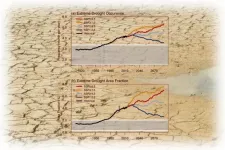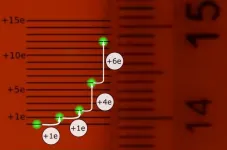(Press-News.org) The most accurate distance measurement yet of ultra-diffuse galaxy (UDG) NGC1052-DF2 (DF2) confirms beyond any shadow of a doubt that it is lacking in dark matter. The newly measured distance of 22.1 +/-1.2 megaparsecs was obtained by an international team of researchers led by Zili Shen and Pieter van Dokkum of Yale University and Shany Danieli, a NASA Hubble Fellow at the Institute for Advanced Study.
"Determining an accurate distance to DF2 has been key in supporting our earlier results," stated Danieli. "The new measurement reported in this study has crucial implications for estimating the physical properties of the galaxy, thus confirming its lack of dark matter."
The results, published in Astrophysical Journal Letters on June 9, 2021, are based on 40 orbits of NASA's Hubble Space Telescope, with imaging by the Advanced Camera for Surveys and a "tip of the red giant branch" (TRGB) analysis, the gold standard for such refined measurements. In 2019, the team published results measuring the distance to neighboring UDG NGC1052-DF4 (DF4) based on 12 Hubble orbits and TRGB analysis, which provided compelling evidence of missing dark matter. This preferred method expands on the team's 2018 studies that relied on "surface brightness fluctuations" to gauge distance. Both galaxies were discovered with the Dragonfly Telephoto Array at the New Mexico Skies observatory.
"We went out on a limb with our initial Hubble observations of this galaxy in 2018," van Dokkum said. "I think people were right to question it because it's such an unusual result. It would be nice if there were a simple explanation, like a wrong distance. But I think it's more fun and more interesting if it actually is a weird galaxy."
In addition to confirming earlier distance findings, the Hubble results indicated that the galaxies were located slightly farther away than previously thought, strengthening the case that they contain little to no dark matter. If DF2 were closer to Earth, as some astronomers claim, it would be intrinsically fainter and less massive, and the galaxy would need dark matter to account for the observed effects of the total mass.
Dark matter is widely considered to be an essential ingredient of galaxies, but this study lends further evidence that its presence may not be inevitable. While dark matter has yet to be directly observed, its gravitational influence is like a glue that holds galaxies together and governs the motion of visible matter. In the case of DF2 and DF4, researchers were able to account for the motion of stars based on stellar mass alone, suggesting a lack or absence of dark matter. Ironically, the detection of galaxies deficient in dark matter will likely help to reveal its puzzling nature and provide new insights into galactic evolution.
While DF2 and DF4 are both comparable in size to the Milky Way galaxy, their total masses are only about one percent of the Milky Way's mass. These ultra-diffuse galaxies were also found to have a large population of especially luminous globular clusters.
This research has generated a great deal of scholarly interest, as well as energetic debate among proponents of alternative theories to dark matter, such as Modified Newtonian dynamics (MOND). However, with the team's most recent findings--including the relative distances of the two UDGs to NGC1052--such alternative theories seem less likely. Additionally, there is now little uncertainty in the team's distance measurements given the use of the TRGB method. Based on fundamental physics, this method depends on the observation of red giant stars that emit a flash after burning through their helium supply that always happens at the same brightness.
"There's a saying that extraordinary claims require extraordinary evidence, and the new distance measurement strongly supports our previous finding that DF2 is missing dark matter," stated Shen. "Now it's time to move beyond the distance debate and focus on how such galaxies came to exist."
Moving forward, researchers will continue to hunt for more of these oddball galaxies, while considering a number of questions such as: How are UDGs formed? What do they tell us about standard cosmological models? How common are these galaxies, and what other unique properties do they have? It will take uncovering many more dark matter-less galaxies to resolve these mysteries and the ultimate question of what dark matter really is.
INFORMATION:
The published ApJL article is available here: https://iopscience.iop.org/article/10.3847/2041-8213/ac0335
A pre-publication is available at: https://arxiv.org/abs/2104.03319
About the Institute
The Institute for Advanced Study is one of the world's foremost centers for theoretical research and intellectual inquiry. Located in Princeton, N.J., the IAS is dedicated to independent study across the sciences and humanities. Founded in 1930, the Institute is devoted to advancing the frontiers of knowledge without concern for immediate application. From founding IAS Professor Albert Einstein to the foremost thinkers of today, the IAS enables bold, curiosity-driven innovation to enrich society in unexpected ways.
Each year, the Institute welcomes more than 200 of the world's most promising post-doctoral researchers and scholars who are selected and mentored by a permanent Faculty, each of whom are preeminent leaders in their fields. Among present and past Faculty and Members there have been 35 Nobel Laureates, 42 of the 60 Fields Medalists, and 21 of the 24 Abel Prize Laureates, as well as many MacArthur Fellows and Wolf Prize winners.
One of the main reasons for the hold-ups in the mass vaccination campaigns against COVID-19 are the precautions that must be taken regarding the handling of the vaccines and their administration. They have to be transported under very specific conditions and the syringes used for their administration must be prepared at the same vaccination site. Healthcare workers must ensure they avoid any sudden movements of the vaccines so as not to affect the vector they use, messenger RNA molecules in the case of the Pfizer BioNTech and Moderna vaccines.
But research led by the Hospital del Mar Pharmacy Department and Neuropharmacology-Neurophar Research Group at Pompeu Fabra University (UPF), may lead to changes in ...
The ability to insert desirable genes into animal or human cells is the basis of modern life science research and of widespread biomedical applications. The methods used to date for this purpose are mostly non-specific, making it difficult for scientists to control which cell will or will not take up a gene. For this gene transfer, the target genes are often packaged into "viral vectors." These are viruses in which part of the genetic material has been replaced by the target genes. When researchers add these viral vectors to cells, the vectors introduce the genes into the cells. This is the principle behind some of the current SARS-CoV-2 vaccines such as those from AstraZeneca or Johnson&Johnson. However, it is difficult - even impossible - to control into which cells the ...
Tsukuba, Japan - Sometimes a dead log isn't just a dead log. This one in Japan turned out to be the habitat of a species previously unknown to science.
In a new study published in the journal Nematology, a University of Tsukuba-led research team has described a new species of nematode found inside bark beetles that emerged from a dead log of a fir tree.
Nematodes, also known as roundworms, are a diverse phylum (category) of unsegmented worm-like animals that live in a wide variety of habitats and have diverse life habits. Many nematodes, including this previously unknown species, are either parasitic or live inside a host organism for the duration of a particular life stage.
The log from the trunk of a fallen Veitch's fir tree (Abies veitchii) was ...
Southeast Asian monsoon region falls in the warm and humid tropics modulated by Asian monsoon. It is home to nearly 15% of the world's tropical forests and one of the biodiversity hotspots in the world.
With the unprecedented urbanization and population growing rate, water scarcity issues have already posed a serious challenge for sustainable development in Southeast Asian monsoon region. However, the impact of anthropogenic forcing, such as greenhouse gases and anthropogenic aerosols, on extreme drought events in the region is still unclear.
Scientists from the Institute of Atmospheric Physics (IAP) of the Chinese Academy of Sciences investigated the observed drought changes over Southeast ...
Researchers at the University of Gothenburg have observed the absorption of a single electron by a levitated droplet with such a magnification that it is visible with the naked eye and can even be measured with a normal millimeter scaled ruler.
Matter in the universe is composed of elementary particles like electrons, protons, and neutrons. They are everywhere, but they are so small that the human eye cannot discern them. In the last century, physicists have proven the existence of these particles through different experiments, but in most cases the observation of the particles have been indirect.
- Electrons are one of these fundamental particles. In 1909, Robert Millikan proved that the charge of the electron is quantized. In other words, there exists a minimum, indivisible ...
Researchers from Skoltech and Saratov State University have designed a simple and easily reproducible labeling system for individual cells that enables researchers to track single cell behavior and migration for tasks requiring extreme precision. The paper was published in the journal ACS Applied Materials and Interfaces.
Modern biomedical science and developmental biology often require scientists to track and trace individual cells, whether it is to establish the best purified cells from various types of cell lines, in particular to select mesenchymal stem/stromal cells best suited for tissue ...
The production of chemicals is a cumbersome business. Often, only a small part of what is actually wanted is produced in the factory. The large remainder is unusable - or even worse. Examples? The defoliant "Agent Orange" used by the US army in the Vietnam War was produced in great hurry. It contained dioxin as an impurity. As a result, not only did trees in the combat zone lose their foliage, but US soldiers and Vietnamese civilians also fell ill with cancer years later.
There are also examples from agriculture: In the production of the insecticide lindane, ...
As a new member of photovoltaic family, antimony trisulfide (Sb2S3) has the satisfactory bandgap of 1.7eV, benefiting the fabrication of the top absorber layer of tandem solar cells. Due to special quasi-one-dimensional structure, it shows advantages of less dangling bonds. Based on these advantages, the vacancy defects upon the surface causing the recombination of the carriers could be reduced sharply, which helps to solve the photovoltaic problems in solar cells.
In the previous studies, the relationships between conformation, chemical composition and ...
Scientists have developed a new method that improves dispensing of viscoelastic fluids - a vital process for circuit board production, 3D printing and other industrial applications
Viscoelastic fluids are difficult to dispense as liquid bridges that form between the substrate and nozzle must be broken
New research has found that twisting these liquid bridges breaks them in a quicker and cleaner way than the conventional method of stretching them
Researchers used high speed imaging to observe that when twisted, a crack forms at the edge of the liquid bridge and propagates towards the center
The underlying mechanism that breaks the liquid bridge was found to be "edge fracture" and is the first time that ...
During flock encounters, a single vocal interaction seems to be sufficient for making the decision of whether to recruit an individual or flock. Parrots are known for their splendid ability to imitate, including the contact calls of other individuals during vocal interactions. Such rapid vocal matching is hypothesised to precede and mediate the formation of new flocks. But how are such interactions perceived by others?
Heidi M. Thomsen, first author and PhD student at the Department of Biology, University of Copenhagen explains:
-"By using a novel experimental design, we were able ...






